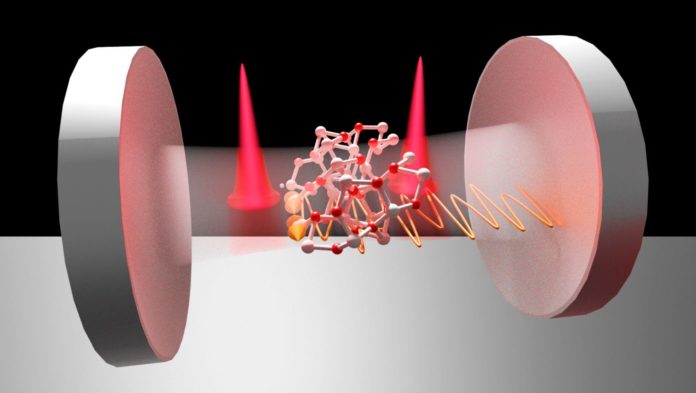Ultrafast atomic vibrations mediate heat transport, serve as fingerprints for chemical bonds and drive phase transitions in condensed matter systems. Light pulses shorter than the atomic oscillation period can not only use a probe but even stimulate and control collective excitations. In general, such interactions are performed with free-propagating pulses.
Optical solitons are stable packets of light waves which are emitted in ultrashort-pulse lasers as a chain of light flashes. These solitons often combine into pairs with very short temporal separation.
Introducing atomic vibrations in the terahertz range, researchers at the Universities of Bayreuth and Wrocław have now solved the puzzle of how these temporal links are formed.
They report on their discovery in Nature Communications.
The dynamics of the coupled light packets can be used to measure atomic vibrations as characteristic “fingerprints” of materials in an extremely fast manner.
“Atomic lattice dynamics commonly remain hidden due to the fast phonon decay compared to the cavity roundtrip period of several nanoseconds.” Study quotes.
In ultrashort-pulse lasers, optical solitons can form particularly tight spatial and temporal bonds. These are also called ultrashort “soliton molecules” because they are stably coupled to each other, similar to the chemically bonded atoms of a molecule.
The research group in Bayreuth used a widely used solid-state laser made of a sapphire crystal doped with titanium atoms to find out how this coupling occurs.
First, a single leading flash of light stimulates the atoms in the sapphire’s crystal lattice to vibrate instantly. This characteristic motion oscillates in the terahertz range and decays again within a few picoseconds (a picosecond corresponds to a trillionth of a second). In this extremely short time span, the refractive index of the crystal changes. When the second flash of light immediately follows and catches up with the first, it senses this change: it is not only slightly affected by the atomic vibrations but can also stably be bound to the preceding soliton. A “soliton molecule” is born.
“The mechanism we discovered is based on the physical effects of Raman scattering and self-focusing. It explains a variety of phenomena that have puzzled science since the invention of titanium-sapphire lasers over 30 years ago. What is particularly exciting about the discovery is that we can now exploit the dynamics of solitons during their generation in the laser cavity to scan atomic bonds in materials extremely rapidly. The entire measurement of a so-called intracavity Raman spectrum now takes less than a thousandth of a second. These findings may help to develop particularly fast chemically sensitive microscopes that can be used to identify materials. In addition, the coupling mechanism opens up new strategies to control light pulses by atomic motions and, conversely, to generate unique material states by light pulses,” explains junior professor Dr. Georg Herink, head of the study and junior professor of ultrafast dynamics at the University of Bayreuth.
“We reveal impulsive stimulated Raman scattering of optical phonons as a fundamental driving force for the coupling of ultrafast temporal solitons inside cavities with crystalline active media. The process is mediated via the Kerr nonlinearity in temporal and spatial domains, and manifests upon inter-soliton motion. As a result, the impulsively stimulated lattice motion generates stable and meta-stable soliton bound-states at Terahertz phonon beats, and more complex trajectories are accessible via cavity tuning. Our results might enable the exploration of transient soliton dynamics for rapid and autonomous time-domain Raman spectroscopy. Furthermore, the underlying coupling mechanism between temporal solitons and phonons offers unprecedented routes to ultrafast cavity phononics.” Study concludes.
The interactions of solitons in optical systems and their applications for high-speed spectroscopy are currently being investigated in the DFG research project FINTEC at the University of Bayreuth.
Journal Reference
- Völkel, A., Nimmesgern, L., Mielnik-Pyszczorski, A. et al. Intracavity Raman scattering couples soliton molecules with terahertz phonons. Nat Commun 13, 2066 (2022). DOI: 10.1038/s41467-022-29649-y
